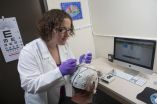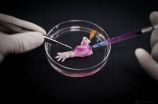(Press-News.org) A new study shows that social and sensory overstimulation drives autistic behaviors. The study, conducted on rats exposed to a known risk factor in humans, supports the unconventional view of the autistic brain as hyper-functional, and offers new hope with therapeutic emphasis on paced and non-surprising environments tailored to the individual's sensitivity.
For decades, autism has been viewed as a form of mental retardation, a brain disease that destroys children's ability to learn, feel and empathize, thus leaving them disconnected from our complex and ever-changing social and sensory surroundings. From this perspective, the main kind of therapeutic intervention in autism to date aims at strongly engaging the child to revive brain functions believed dormant. Researchers at the Swiss Federal Institute of Technology in Lausanne (EPFL) completed a study that turns this traditional view of autism completely around.
The study demonstrates that, in rats exposed to a known autism risk factor, unpredictable environmental stimulation drives autistic symptoms at least as much as an impoverished environment does, and that predictable stimulation can prevent these symptoms. The study is also evidence for a drastic shift in the clinical approach to autism, away from the idea of a damaged brain that demands extensive stimulation. Instead, autistic brains may be hyper-functional and thus require enriched environments that are non-surprising, structured, safe, and tailored to a particular individual's sensitivity.
"The valproate rat model used is highly relevant for understanding autism, because children exposed to valproate in the womb have an increased chance of presenting autism after birth," says Prof. Henry Markram, co-author of the study and father of a child with autism. Accordingly, rats exposed to valproate in early embryonic development demonstrate behavioral, anatomical and neurochemical abnormalities that are comparable to characteristics of human autism.
The scientists here show that if rats are exposed to this prenatal autism risk factor and reared in a home environment that is calm, safe, and highly predictable with little surprise -- while still rich in sensory and social engagement -- do not develop symptoms of emotional over-reactivity such as fear and anxiety, nor social withdrawal or sensory abnormalities.
"We were amazed to see that environments lacking predictability, even if enriched, favored the development of hyper-emotionality in rats exposed to the prenatal autism risk factor", says Henry Markram.
The study critically shows that in certain individuals, non-predictable environments lead to the development of a wider range of negative symptoms, including social withdrawal and sensory abnormalities. Such symptoms normally prevent individuals from fully benefiting from and contributing to their surroundings, and are thus the targets of therapeutic success. The study identifies drastically opposite behavioral outcomes depending on levels of predictability in the enriched environment, and suggests that the autistic brain is unusually sensitive to predictability in rearing environment, but to different extent in different individuals. The results were received with enthusiasm by the autism community, which consistently reports the high sensitivity of people with autism to change and to sensory stimulation.
The study is strong evidence for the Intense World Theory of Autism, proposed in 2007 by neuroscientists Kamila Markram and Henry Markram, both co-authors on the present study. This theory is based on recent research suggesting that the autistic brain, in both humans and animal models, reacts differently to stimuli. It proposes that an interaction -- between an individual's genetic background with biologically toxic events early in embryonic development -- triggers a cascade of abnormalities that create hyper-functional brain microcircuits, the functional units of the brain. Once activated, these hyper-functional circuits could become autonomous and affect further brain functional connectivity and development. These would lead to an experience of the world as intense, fragmented, and overwhelming; while differences in severity between persons with autism would stem from the system affected and the timing of the effect. The authors acknowledge the need to test these ideas in humans.
If children with autism are indeed more neurobiologically sensitive to the environment than other children as a result of early brain hyper-function, then predictable environmental stimulation tailored to an individual's specific hyper-sensitivity could significantly improve quality of life, by preventing or ameliorating the debilitating autistic symptoms of sensory overload and anxiety or fears, and allow the child to flourish.
"A stable, structured environment rich in stimuli could help children with autism, by providing a safe haven from an overload of sensory and emotional stimuli. In contrast, an environment with many unpredictable, changing stimuli could make their symptoms worse, raising anxiety and fear and making these children retract into a bubble," says Kamila Markram.
"Importantly, such constructive interactions with a safe and predictable world at key developmental sensitive periods early on could enhance coping and succeeding in subsequent less structured or unfamiliar contexts, and give place to a harmonious individual development," says Monica Favre, first author of the study.
This study has immediate implications for clinical and research settings, because enhanced brain processing and sensitivity to environmental surprises need to be considered as possible defining characters of autism. This breakthrough suggests that if brain hyper-function can be diagnosed soon after birth, at least some of the debilitating effects of a supercharged brain can be prevented, not by environmental enrichment per se, but by highly specialized environmental stimulation that is safe, consistent, controlled, announced and only changed very gradually at the pace determined by each child.
INFORMATION:
You might not need to remember those complicated e-mail and bank account passwords for much longer. According to a new study, the way your brain responds to certain words could be used to replace passwords.
In "Brainprint," a newly published study in academic journal Neurocomputing, researchers from Binghamton University observed the brain signals of 45 volunteers as they read a list of 75 acronyms, such as FBI and DVD. They recorded the brain's reaction to each group of letters, focusing on the part of the brain associated with reading and recognizing words, and found ...
San Antonio -- June 2, 2015 -- A close-up of Comet 67P/Churyumov-Gerasimenko by NASA's ultraviolet instrument surprised scientists by revealing that electrons close to the comet's surface -- not photons from the Sun as had been believed -- cause the rapid breakup of water and carbon dioxide molecules spewing from the surface.
Since last August, the European Space Agency's Rosetta spacecraft has orbited within a hundred miles of the comet in this historic mission. The spectrograph onboard, named Alice, specializes in the far-ultraviolet wavelength band and was developed ...
Menopausal hormone therapy (MHT) given to recently postmenopausal women in the US for up to four years does not improve cognition, but may have some positive benefits for some mood symptoms, according to a study published by Carey Gleason and colleagues from the University of Wisconsin, Madison, USA, in this week's PLOS Medicine.
The researchers reached these conclusions by conducting a randomized placebo-controlled clinical trial (the KEEPS-Cog trial), including 693 recently postmenopausal women living in the US who were randomly assigned to receive either oral estrogen ...
What if your doctor told you that your weight is somewhere between 100 and 400 lbs.? With any ordinary scale every patient can do better at home. Yet, one patient can't: the Milky Way. Even though today we peer deeper into space than ever before, our home galaxy's weight is still unknown to about a factor of four. Researchers at Columbia University's Astronomy Department have now developed a new method to give the Milky Way a more precise physical checkup.
The Milky Way consists of roughly 100 billion stars that form a huge stellar disk with a diameter of 100-200 thousand ...
PHILADELPHIA--(June 2, 2015)--Senescence, a phenomenon in which cells cease to divide and grow, can be caused by everything from natural DNA damage to treatment with chemotherapy. However, several mechanisms allow for cells to bypass senescence and grow out of control, eventually becoming cancerous. Now, scientists at The Wistar Institute have identified how a specific variant of a key protein complex found in human cells called condensin can reorganize a cell's genetic architecture in such a way as to promote senescence, making it an important facilitator in a cell's ...
A team of Massachusetts General Hospital (MGH) investigators has made the first steps towards development of bioartificial replacement limbs suitable for transplantation. In their report, which has been published online in the journal Biomaterials, the researchers describe using an experimental approach previously used to build bioartificial organs to engineer rat forelimbs with functioning vascular and muscle tissue. They also provided evidence that the same approach could be applied to the limbs of primates
"The composite nature of our limbs makes building a functional ...
Who says you can't do two things at once and do them both well?
A new University of Florida study challenges the notion that multi-tasking causes one or both activities to suffer. In a study of older adults who completed cognitive tasks while cycling on a stationary bike, UF researchers found that participants' cycling speed improved while multi-tasking with no cost to their cognitive performance.
Results of the study, which was supported by a grant from the National Institute on Aging, were published May 13 in the journal PLOS ONE.
The discovery was a surprise finding ...
COLUMBUS, Ohio - A new nationwide study reveals that the kind of cities that attract college graduates has changed since the 1990s.
In the 1990s, grads were moving to cities with fast-growing "smart" industries in fields like high tech, the study found. But since 2000, with a less vibrant national economy, college graduates are flocking toward the biggest cities with the biggest labor markets and the best chances of landing a job.
In fact, the effect of city population size in attracting college grads was nearly four times as large in the 2000s as it was in the 1990s, ...
(New York, NY, June 1, 2015)-- The Big Apple is one of the most walkable cities in the nation, providing many opportunities for physical activity, and New Yorkers are more likely to exercise regularly than the average U.S. adult. But they are also sitting far more than what is considered healthy.
According to a new study published by the U.S. Centers for Disease Control and Prevention in its journal Preventing Chronic Disease, the average New York City resident sits more than seven hours a day--greatly exceeding the three hours or more per day that is associated with ...
HOUSTON - (June 2, 2015) - Hispanics and women in Texas showed the largest percentage of reductions in rates of uninsured since enrollment began in the Affordable Care Act's (ACA) Health Insurance Marketplace, according to a new report released today by the Episcopal Health Foundation and Rice University's Baker Institute for Public Policy.
The report found that from September 2013 to March 2015, the percentage of Hispanics without health insurance fell 38 percent (from 39.1 percent uninsured to 24.3 percent), more than any other ethnic group. The percentage of uninsured ...

